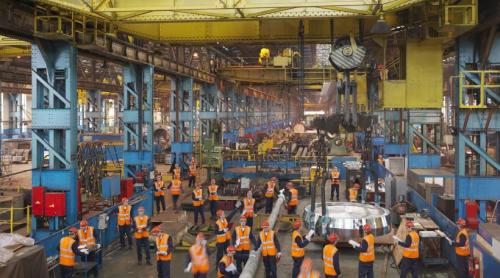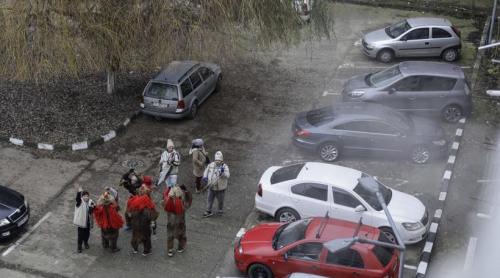
CSAT (the Supreme Council for the Country Defense) has become a place of political confrontations, and major decisions are to be taken after the Presidential elections.
The Ministry of Defense has a much lower budget in 2009 as far as the "endowment" is concerned. Secretary of State Aurel Lascu, Head of Armaments Department, has said that the Ministry has about 200 million US dollars to finance the ongoing endowment programs of the Army.
Initially, the allocated budget sums were almost double, but the budget adjustments reduced the sum to this minimal level. The repeated chronic under-financing of the Army budget determined procurement and payment delays and renegotiations with the suppliers each year. According to the same official there are 6 endowment programs planned for the end of this year.
Although the weapons procurement chapter is "thin", the discussions about this topic refer to sums ten times larger that are supported by the "golden" acquisition - the multi-purpose aircraft. This program is estimated to cost around 4 billion euros, and it has obviously become a target for the big players in the industry. Several channels and higher levels have been used to influence Romania. It is no secret that the procurement of this type of aircraft has also become a political struggle between the institutions in the countries bidding for it.
Performance, price, and technical level are secondary, the word of the Air Army influencing the purchase in a very small extent. If, during the Tariceanu Government, the Defense Minister Teodor Melescanu evoked the potential purchase of a European aircraft - Swedish, French or German-Italian-Spanish-English - now, they speak about the American version of it.
In fact, according to the declaration of the new U.S. Ambassador in Bucharest, Mark Gittenstein, "the U.S. Government is analyzing a letter sent by the Romanian Government regarding the F-16 aircraft. Currently, it is being processed and I do not know what the result will be", the ambassador said, quoted by Mediafax. However, he gave a clear description of the American plan: "We want (the decision) to take into consideration the F-35 and F - 16 is an important intermediate step. I think you'll hear more on this subject in the coming weeks".
OFFERS
Therefore, things are going in a more difficult direction. In this regard, Defense Minister Stânişoara said the issue regarding the acquisition of multi-purpose aircrafts would be on the CSAT table by the end of the year. But the current team at CSAT will not take a final decision, because they are waiting for the result of the Presidential elections. The calendar shows that by the beginning of 2010 the equipment suppliers already agreed by the Air Force will increase their pressure on the political factors in Romania. Since Traian Băsescu will not get to the White House until the end of his mandate, there is still room for European hopes as well.
Sarkozy has managed to sell Brazil, during his recent visit, 38 Rafale planes. Will he offer them to Romania as well? Eurofighter is produced by an aviation consortium involving Germany, Britain, Spain and Italy, very important countries for the EU decisions. Sweden, the EU president, will obviously push the Gripen forward. So ...
The Romanian taxpayer will certainly ask himself one thing, especially due to the crisis situation,: "Who decided that Romania needs exactly 48 devices?" The number was set in 2005 by CSAT, but the operational requirements have not been evaluated since, although the political, military and economical realities have changed significantly.
NEW CHALLENGES
We believe that these requirements have been established in accordance to the conclusions of the conflict in Georgia and the fluctuating situation in Transnistria. What could Georgia make with the planes even if they had the F-16? The supply of ammunition was supposed to be made from a supplier that could not arrive in time. So? Romania, in the event of aggression, must be resistant until the moment of receiving aid from its allies. That requires at least anti-aircraft and anti-tank defense.
Or, one knows that a rocket is cheaper than a plane. Since the U.S. withdrew from the missile shield program in Poland and the Czech Republic, let's take a look at the decisions of our Polish ally, which is in a similar situation with us. They purchased F-16s, Spartan aircrafts, European missile systems, and German warships.
SMOKING HEARINGS
Last week, the Senate Defense Committee invited Minister Stănişoară to an official hearing. The reason that started the hearing was quickly defused: the involvement of the Basescu family in ammunition trade. The committee also discussed about several issues launched in the recent weeks by certain lobby groups. The fact that the procurement budget "shrinked" emphasized the "hunger" of the military equipment sellers. Therefore, there were some harsh attacks and false information meant to force a certain decision in the Ministry of Defense.
CANCELED PROGRAMS
The most recent case is an event related to a program aimed at ground-based air defense. In June, the Head of the Major Aerial Forces, General Ion-Aurel Stanciu, said after his return from the informal meeting of the Air Force Heads in Europe held in Paris: "The first really gratifying fact is the intitiation of the SHORAD/VSHORAD Program, after many years of prevarication. The initiation started by purchasing the Mistral and VL-MICA systems, made by the largest European manufacturer in this field, MBDA ... As a corollary of the things said, there is only bitterness caused by years lost due to vanity and indecision".
These are words that now have a more concrete sense, because, during the hearings, the committee debated on an idea that appeared in the newspapers at first, the idea saying that MBDA, the world leader in the production of missiles, didn't exist. The media torpedo was designed to justify the annulment of a Government Decision that agreed with the program supported by the Air Force Head. How did they manage to cancel this Government Decision? Could it be because of a company that modernizes military junk, which managed to become part of the all the agreements of the Army so far?
MBDA could also mean problems for the continuation of the old and already rusty system - HAWK, bought from Netherlands right before the pre-accession to NATO. The system has never worked since, but it consumed significant funds every year and ... surprise ... it appears in a (not canceled) GD for which funding was found.
The annulment of the program with MBDA has started, according to certain diplomatic sources, a strong query in Paris, where pragmatic President Sarkozy, delighted by the progress of the cooperation with the Romanian army, had decided to support Romania for an important European Commissioner position.
Another major program is the one regarding the ground troops, that is the armored troop-carriers' replacement. Out of the hundreds of vehicles that are to be delivered, 31 Pyranha troop-carriers have been contracted so far and delivered by MOWAG, a Swiss company. On the Afghanistan battlefield, the new troop-carriers are not part of the combat missions, because they have problems after...modernization. The machine gun delivered by BROWNING did not quite match the turret and sighting system and the shields are not powerful enough. The army needs approximately 100,000 for each device to fix the shields only.
Why did they go around the autochthonous arms industry for this product and use another institutionalized and patched program? The U.S. Ambassador also supported General Dinamics, the company that has incorporated the Swiss in a powerful joint venture of the defense industry and, of course, is aware of the "Pyranha file" that was filled with inefficient costs.
The relationship with Britain, from whom they purchased the two frigates, got complicated because of the failure of the offset program. According to Secretary of State Aurel Lascu, they covered only 11% -12% of this program, and the United Kingdom cannot be forced to contract the rest (several hundred million euros). There are people in the Navy saying that the frigates should be discarded, that we should accept the costs that appeared so far and build new ones in cooperation with Germany.
Otherwise, upgrading the frigates would block other purchases and dozens of other millions would be spent uselessly.
WHO ARE THE MODERNIZERS?
The fact that the endowment budget will be allocated for modernization, but not to purchase new equipment that would open by offset the industrialization, is a dead end.
An analysis of permanent subscribers to modernizations can be very interesting. Only then, one can enter an ounce of fairness in the equation with many unknowns of equipping the Army.












